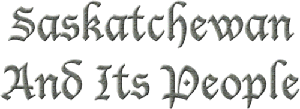THE BARR COLONY. (con't)
humorist, and the colonists sensibly enriched his stock of stories. He
went in again the first fall, and travelled over five hundred miles in order
to see how the settlers were fixed for the winter. Many of the colonists
were away working and many had left. He reported about 850 in the
main colony at Lloydminster and 250 outside the reserve; at Jack Fish
Lake were 114; at Bresaylor 39, and at Elgin Hill, south of Battleford 39.
He thought about twenty families would need assistance, in the winter.
He said the average broken was about two and a half acres; some had
thirty or forty acres broken, but many had merely a kitchen garden.
He put the number in the movement at 1,600.
Mr. Speers made arrangements for certain families to be accommodat-
ed in the police barracks at Battleford. Good, large, well banked tents
(previously referred to) with big stoves were to be provided pending the
erection of a large immigration building, the material for which would
be hauled from Fort Pitt. There appears to have been delay owing to
the low water in the Saskatchewan, on which river the material was to
be floated down to the Fort. A good many settlers were working near
by on a grade of the Canadian Northern Railway. Hay was short;
enough had not been put up in the first instance, and a good deal had
been destroyed by prairie fires.
Much more might be written about this great colony but we will only
add that it stands out as an example of what British tenacity and endur-
ance can achieve in the face of inexperience and other difficulties. The
hamlet of 1901 is now a thriving town of fifteen hundred inhabitants and
is in the centre of one of the best farmed districts in Canada.
We are informed that Bishop Lloyd has it in contemplation to write
a history of the Barr Colony to be published in book form. We are sure
if His Lordship carries out his intention, the public will have an inter-
esting book almost unique of its kind.
Bibliography follows:

